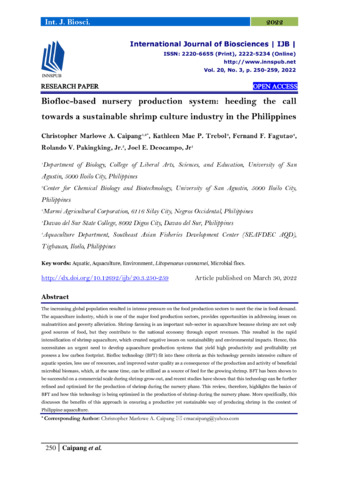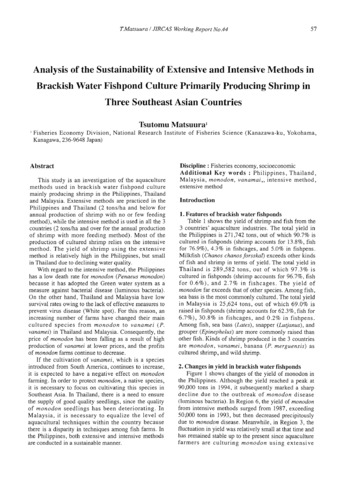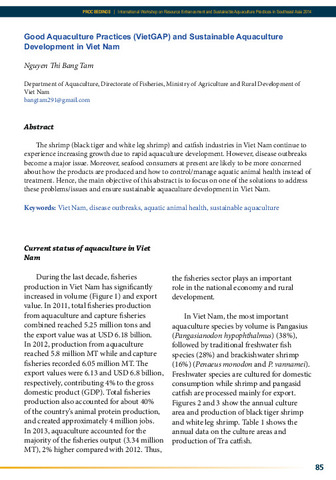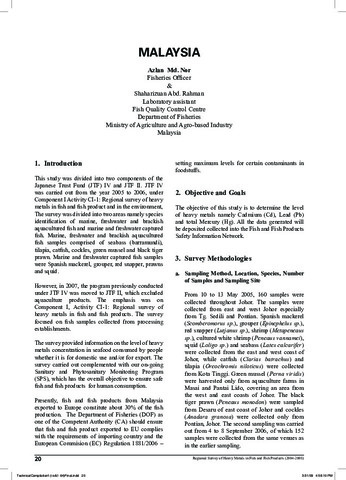Biofloc-based nursery production system: Heeding the call towards a sustainable shrimp culture industry in the Philippines

Associated URL
www.innspub.netDate
2022Author
Page views
791Metadata
Show full item recordCited times in Scopus
Share
Abstract
The increasing global population resulted in intense pressure on the food production sectors to meet the rise in food demand. The aquaculture industry, which is one of the major food production sectors, provides opportunities in addressing issues on malnutrition and poverty alleviation. Shrimp farming is an important sub-sector in aquaculture because shrimp are not only good sources of food, but they contribute to the national economy through export revenues. This resulted in the rapid intensification of shrimp aquaculture, which created negative issues on sustainability and environmental impacts. Hence, this necessitates an urgent need to develop aquaculture production systems that yield high productivity and profitability yet possess a low carbon footprint. Biofloc technology (BFT) fit into these criteria as this technology permits intensive culture of aquatic species, less use of resources, and improved water quality as a consequence of the production and activity of beneficial microbial biomass, which, at the same time, can be utilized as a source of feed for the growing shrimp. BFT has been shown to be successful on a commercial scale during shrimp grow-out, and recent studies have shown that this technology can be further refined and optimized for the production of shrimp during the nursery phase. This review, therefore, highlights the basics of BFT and how this technology is being optimized in the production of shrimp during the nursery phase. More specifically, this discusses the benefits of this approach in ensuring a productive yet sustainable way of producing shrimp in the context of Philippine aquaculture.
Suggested Citation
Caipang, C. M., Trebol, K. M. P., Fagutao, F., Pakingking, R. V., Jr., & Deocampo, J. E., Jr. (2022). Biofloc-based nursery production system: Heeding the call towards a sustainable shrimp culture industry in the Philippines. International Journal of Biosciences , 20(3), 250-259. https://doi.org/10.12692/ijb/20.3.250-259
Subject
Taxonomic term
Collections
- AQD Journal Articles [1249]
Related items
Showing items related by title, author, creator and subject.
-
Analysis of the sustainability of extensive and intensive methods in brackish water fishpond culture primarily producing shrimp in three Southeast Asian countries
Matsuura, Tsutomu (Japan International Research Center for Agricultural Sciences, 2006)This study is an investigation of the aquaculture methods used in brackish water fishpond culture mainly producing shrimp in the Philippines, Thailand and Malaysia. Extensive methods are practiced in the Philippines and ... -
Good aquaculture practices (VietGAP) and sustainable aquaculture development in Viet Nam
Nguyen, Thi Bang Tam (Aquaculture Department, Southeast Asian Fisheries Development Center, 2015)The shrimp (black tiger and white leg shrimp) and catfish industries in Viet Nam continue to experience increasing growth due to rapid aquaculture development. However, disease outbreaks become a major issue. Moreover, ... -
Regional survey of heavy metals in fish and fish products: Malaysia
Nor, Azlan Md. (Marine Fisheries Research Department, Southeast Asian Fisheries Development Center, 2008)The paper presents the results of the survey that was conducted to determine the level of heavy metals namely cadmium, lead, and total mercury among the marine, freshwater and brackishwater (aquacultured) fishes in Malaysia. ...



